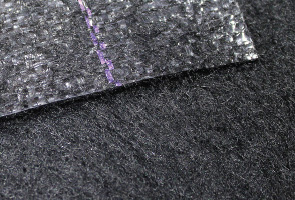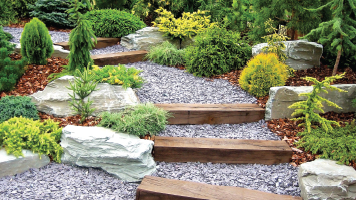 Heavy Duty Landscape Fabric Heavy Duty Landscape Fabric
Ranging from 4 oz to 4.75 oz in material weight, this heavy duty, commercial-grade landscape fabric provides dependable weed protection as well as soil stabilization. Designed specifically for heavy-duty weed control, the fabric features a blended woven / non woven material composition. This results in increased tensile strength while still retaining a high water flow rate. When utilized as a ground cover fabric, clearly marked planting stripes provide easy planting alignment.
Tip: When shopping for a weed barrier fabric be very selective on the quality of fabric you purchase. Many retail garden centers and online stores offer fabrics without written testing specifications. These fabrics are typically “economy-grade” and will over time provide “economy-grade” weed protection.
|
|
Using Heavy Duty Landscape Fabric To Prevent Weeds

Heavy-Duty Landscape Fabric
In a designed landscape various landscaping materials are commonly used for various purposes. When it comes to preventing weeds, choosing a commercial-grade heavy duty landscape fabric is essential for proper weed reduction and prevention.
Non-Ideal Materials To Steer Clear Of:
Many gardeners start out trying "economy" solutions to weed control. Some natural, some unnatural. One natural option are different types of natural mulches. Organic mulches will eventually decompose and increases once in contact with soil. Unfortunately, as the decomposition increases the ground becomes a fertile bed for weeds.
Crushed stones are inorganic mulch and will not decompose. Stones will quickly work their way into the soil, they draw enormous heat and are a mess to clean up.
Similar to crushed stone, black plastic will not decompose but is much easier to clean up. Unfortunately, like crushed stone, it draws enormous heat and also prevents air, nutrients and water from getting into the soil. This will cause problems when it's time to place your plants in this area.
Landscape Fabrics:
Unlike black plastic, landscape fabrics let in air, nutrients and water and is a clean, durable weed barrier. If organic mulch is placed over landscape fabric it will break down much slower than if placed directly onto the soil.
In areas that are larger than the landscape fabric, use as many sheets as needed to cover the area by placing them adjacent to each other and overlapping. If they are not overlapping, weeds can sprout up through the seams. The makers of landscape fabric advise overlapping by 3 inches but play it safe, increase the overlapping to 6 inches.
When installing the fabric, make sure the shiny side faces up and pin down or use heavy objects to hold the fabric down if it's a windy day, otherwise it could blow away. Landscape fabric pins can be inserted into the fabric to pin it down.
Landscaping Pins:
Do not go overboard with pins, once you have placed mulch over the fabric the weight will hold it down. It's suggested you place pins every ten feet along the edges and the overlapping seams. After placing the mulch over the fabric, use a steel rake to spread it out evenly.
Once The Weed Barrier Is In Place:
Once your barrier is firmly in place and it's time for planting, what's the next step? It's time to make incisions into the barrier so you can properly place your plants. Do not go overboard with these incisions and do not cut huge circles out of the fabric. Here are the steps to properly create incisions:
- Keep the incisions as small as you can.
- Make x-shaped cuts in the fabric vs cutting out sections of the fabric
Installation Of Plants Through The Landscape Fabric:
Keep in mind, this area of the fabric is a planting bed and you will be glad you took the time and energy to control the weeds. By taking your time to ensure weeds will not pop up and overtake the area, you have saved yourself a great deal of unwanted hard work.
Because you created an x-shaped incision, you have created four flaps. Separate the flaps so you will have access to the soil area for planting. You should have a container or wheel barrow nearby instead of shoveling the soil onto the landscape fabric. Remember that the less soil that you have on top of the landscape fabric the less potential weeds you will have because reduced soil thickness will help to reduce weed-seed germination.
Once your small hole has been dug out, place your plant. Place soil around the plant and tamp down to curtail air pockets. Once you have finished planting, take the four flaps of cut fabric and place them snugly against the base of your plant. You should not have any gaps in the fabric as this, in turn, will lead to weeds. After all is done, a new layer of mulch is applied but away from the base of the plant. If mulch is up against the base of the plant, you will attract diseases and pests.

Common Mistakes:
Landscaping fabric is truly one of the best ways to cut back on weeds that can harm your garden plants. As great as this fabric is, it's not 100% weed resistant.
A very common mistake is cutting the fabric too short. In order to get a perfect size, lay the fabric over the area you are going to be using and then cut. You probably should cut it a little bit larger than the area.
Always make sure your fabric has been pinned or staked in place, weather conditions such as high winds can carry your fabric away.
Keep in mind that no matter what ground you place your fabric on, it will not necessarily stay intact. Ground freezes and then thaws causing the fabric to move. If there are twigs or rocks on the ground they can tear the fabric. If torn, this will lead to weeds, slugs and other insects creeping into your garden.
Do not lay down too much mulch as it can hamper your plant's roots from getting proper nutrients, air and water. Also, weeds don't need a great deal of mulch to start growing, so only apply a 2 to 3 inch layer.
Conclusion:
|
Landscaping technology has come a very long way and landscaping fabric is an excellent choice for preventing weeds, diseases and pests. Unlike black plastic, landscaping fabric is porous allowing air, water and nutrients to get into the soil and feed your plant's roots.
|
Why Weed Control Landscape Fabric Is Superior To Plastic
You are ready to plant your garden but you totally forgot to find a way to keep weeds down. There are really two options out there: plastic sheeting or landscape fabric. Both are good options for preventing weeds in your garden but fabric provides advantages that plastic will not offer. While landscaping fabric will seem a little more expensive, but over time it will be more economical. It will last a longer period of time, will protect your plants from the elements, and give you a very healthy, vibrant garden for your property. The following are some excellent reasons why landscape fabric is a better choice.
Fabric Will Help Regulate The Soil's Temperature
Unlike fabric, plastic is known to heat up soil temperatures from the ground and atmosphere which can damage your plants. The only advantage plastic has is in very cold temperatures. The downside, plastic has holes allowing water to become trapped below the lining without allowing for evaporation. At that point, ice will form under the plastic and kill your plants. Fabric, on the other hand, will regulate the soil temperature.
Landscape Fabric Allows Nutrients To Enter The Garden
Unfortunately, plastic will prevent fertilizers from reaching the plants. Landscape fabric is permeable for liquids such as water or fertilizers to penetrate the fabric and access the soil around the plants. Plastic will prevent liquids from passing through and getting to the root systems.
A good quality landscape fabric will allow water through the covering to give your plants the water and nutrients they need to remain healthy.
Plastic is normally used as a waterproofing material. It's used in applications to keep water out. The downside, when dealing with plants, the plastic will keep water from reaching the root systems of the plants. If plastic is covering the roots, the plants will never get water. Fabric allows water to penetrate the root systems to help your plants grow.
Fabric Deters The Growth Of Mold
As plastic hinders water, it will prevent excessive moisture from evaporating. If the root systems of your plants become too wet, there's a good chance your plants will develop mold. Fabric circulates air so water can evaporate naturally.
Another downside to plastic, as air cannot circulate, your plants will suffocate. Using fabric, air will enter the soil and into the root systems allowing your plants to thrive.
UV light from the sun along with the fabric's ability to breathe will block the environment that produces mold and bacteria. Plastic sheeting used as a ground barrier will not allow UV light to reach the soil. In turn, it will increase the potential for plant diseases to grow and damage your plants. The fabric allows the UV light to reach the soil and kill cultures and seriously harm your plants.
Landscape Fabric is Worth the Cost
If you use plastic as a ground cover it will be less expensive but keep in mind, you will not be able to water your plants from above. You will have to invest in a watering system. Installing irrigation will raise the cost of your plant garden a great deal, especially if you end up with all your plants dying and having to be replaced.
Also, a heavy duty ground cover fabric will last for a longer period of time. Fabric will give you approximately 2 to 15 years (depending on the grade) and plastic will have to be thrown out and replaced every year. Plastic material can become brittle and break apart very easily after just a few months. You will be better off investing in landscape fabric over plastic covering.
Fabric Will Control Erosion
Over time, landscape fabric will degrade and become a part of the soil. The process is very slow and will help to prevent soil runoff from the rain while protecting your garden from erosion. Landscape fabric will secure the soil below and resist natural erosion or soil degradation.
Plastic surfaces are very slick, not allowing friction for the soil which means none of the erosion control that is found in landscape fabric. Over time, as the plastic breaks down it will look really bad and will not help in controlling erosion. As a matter of fact, it will increase erosion when the soil washes over the smooth plastic surface. Also, it is not recommended to use plastic on hills and expect any form of good erosion protection.
Landscape Fabric is Rip and Tear Resistant
Landscape fabric is not as likely to rip and tear as plastic and can be patched up with little to no effort. Plastic landscaping can be a big problem when it becomes damaged and falls apart. Once the plastic sheeting is torn, you will have to start over again because plastic is not easy to repair. Damaged, torn plastic will allow the seepage of weeds, leaving the barrier less effective in protecting against weeds.
Landscape Fabric is Visually Superior
This might seem strange as you will not see the landscape fabric because it's hidden below the mulch, so who will notice it? Well, over time, through erosion or movement of rocks or mulch, the weed barrier will become exposed and when that happens, it can be a pretty ugly sight to behold. You will probably go out of your way to cover it up as quickly as possible.
The bottom line, you have created your garden to help your plants grow and make your property look fantastic. The last thing you need is to stare at a huge plastic cover that has taken over the garden and looks really bad. With either material, you can cover them up with mulch or rocks but plastic covers will find a way of showing up over time.
When it rains, the material will push up to the side and become exposed over time. That is one good reason why using black plastic as a weed barrier is not a particularly good idea. Traditional geotextile landscape fabric will let water drain more efficiently. The water will enter the soil and not wash the rocks or mulch away. Visibly, you will have a much better look. The fact is, over time plastic will start to look really bad.
We know that you want your garden to be as weed-free as possible and look aesthetically pleasing. The two leading solutions are fabric and plastic landscaping materials. Both are the most popular choices and the cheapest alternatives for bedding lining to protect your garden. That said, fabric material has many more advantages over plastic sheeting. Landscape fabric has become the economic choice. It offers a more environmentally-friendly alternative while allowing your plants to grow and remain healthy.
As mentioned, the longevity and overall cost of landscape fabric will save you a great deal of time and will not leave you covering up the material as erosion takes hold. All-in-all, the cost will be a significant savings when choosing landscape fabric over plastic. Plastic will only serve you for one season while landscape fabric can be used for years to come.
|
|
|